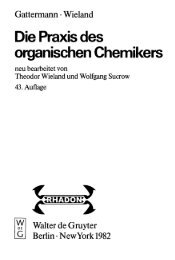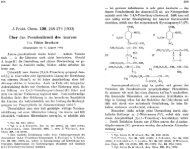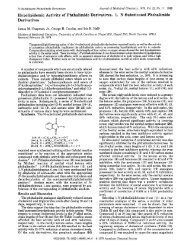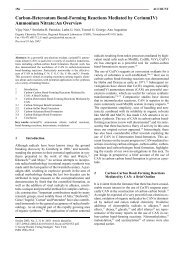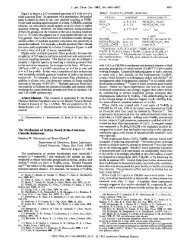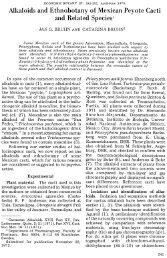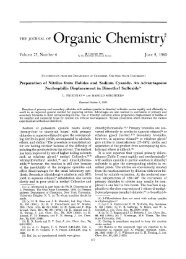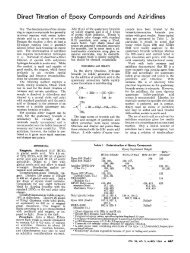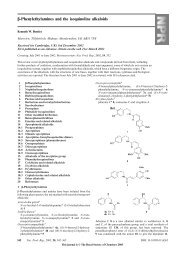You also want an ePaper? Increase the reach of your titles
YUMPU automatically turns print PDFs into web optimized ePapers that Google loves.
134 D. Waumans et al. / Forensic Science International 143 (2004) 133–139<br />
results with impurity profiles obtained from seized PMA<br />
preparations.<br />
2. Methods and techniques<br />
2.1. Chemicals and reagents<br />
All solvents used in this work were of analytical grade and<br />
purchased from Acros Organics (Geel, Belgium). Anise oil<br />
(China, derived from Illicium verum) was obtained from<br />
Taiga International NV (Breendonk-Puurs, Belgium). All<br />
other reagents had been acquired from Merck (Darmstadt,<br />
Germany).<br />
2.2. Instrumentation<br />
Sample analysis was effected with gas chromatography–<br />
mass spectrometry (GC/MS), viz. an Agilent 6890 Plus gas<br />
chromatograph equipped with an Agilent 5973N mass<br />
selective detector (MSD) and electronic pressure programming.<br />
Helium was used as a carrier gas at a constant<br />
linear flow rate of 1.0 mL/min; the column was a<br />
30 m 0:250 mm 0:25 mm VF-5 MS factorFour capillary.<br />
The mass spectrometer operated from 36 to 400 amu in<br />
electron impact (EI) mode with an ionization energy of<br />
70 eV. A solvent delay of 4.00 min was applied. Two<br />
different oven temperature programs and injection modes<br />
were used. Reaction mixtures: 1 mL injection (split 1:50),<br />
oven programming: 50 8C (held for 1 min), 35 8C/min to<br />
100 8C, 10 8C/min to 270 8C (held for 5 min). Seized sample<br />
screening: 1 mL injection (split 1:10), 50 8C (held for 1 min),<br />
5 8C/min to 270 8C.<br />
2.3. Synthesis procedures<br />
2.3.1. Preparation of performic and peracetic acid<br />
Performic acid was prepared by adding 6.8 g freezer-cold<br />
30% hydrogen peroxide to 24.0 g formic acid (98–100%).<br />
This mixture is stirred for ca. 1 h before using it in further<br />
syntheses. Due to the instability of performic acid, the<br />
solution has to be prepared fresh for every experiment. A<br />
stock solution of peracetic acid was prepared by combining<br />
288.0 g of 30% hydrogen peroxide and 4.0 g concentrated<br />
sulfuric acid with 100.0 g glacial acetic acid. The reaction<br />
mixture was stored for 5 days in a dark and well-ventilated<br />
place, after which it was ready for use [13].<br />
2.3.2. Peracid oxidation of <strong>anethole</strong><br />
2.3.2.1. Peracid oxidation of <strong>anethole</strong> dissolved in acetone.<br />
A 250 mL round-bottomed flask was equipped with a magnetic<br />
stirbar and a thermometer, and charged with a solution<br />
of 6.0 g anise oil in 30 mL acetone. Performic acid solution<br />
was added at such a rate that the reaction mixture temperature<br />
did not exceed 38 8C. After addition of the whole<br />
performic acid solution, the reaction was allowed to continue<br />
for ca 12 h. The reaction mixture was poured in its equal<br />
volume of cold distilled water (dH2O) and extracted with<br />
2 50 of mL dichloromethane (DCM). The yellow organic<br />
phase was isolated and washed with 75 mL of dH2O, after<br />
which the organic phase was dried over Na2SO4. After<br />
evaporation of the solvent under reduced pressure, an aromatically<br />
scented yellow oil weighing 8.1 g remained.<br />
Peracetic acid: substituting performic acid for 25.5 g<br />
peracetic acid solution yielded 5.8 g of a yellow oil after<br />
a similar work-up.<br />
For both reaction mixtures, 100 mL of the oil was dissolved<br />
in 5 mL of methanol for further GC/MS analysis.<br />
2.3.2.2. Peracid oxidation of <strong>anethole</strong> dissolved in dichloromethane.<br />
A 250 mL round-bottomed flask was equipped<br />
with a magnetic stirbar and a thermometer, and charged with<br />
a solution of 6.0 g anise oil in 25 mL of DCM. Performic<br />
acid solution was added to the vigorously stirred reaction<br />
mixture at such a rate that the reaction mixture temperature<br />
did not exceed 38 8C. The reaction was allowed to continue<br />
another 12 h after addition of the final performic acid<br />
solution. Subsequently, the reaction mixture was carried<br />
over to a separation funnel and the organic layer isolated.<br />
The aqueous phase was extracted with 50 mL of DCM and<br />
thereupon discarded. The combined organic phases were<br />
washed with 3 50 mL of dH 2O, after which it was dried<br />
over Na2SO4. This yielded 5.8 g of a bordeaux red viscous<br />
oil<br />
Peracetic acid: substituting performic acid for 25.5 g<br />
peracetic acid yielded 4.9 g of a yellow oil after a similar<br />
work-up.<br />
For both reaction mixtures, 100 mL of the oil was dissolved<br />
in 5 mL of methanol for further GC/MS analysis.<br />
2.4. Extraction method<br />
An aliquot of a seized sample (100 mg for powder and<br />
capsule content, 75 mg for pulverized tablet) was dissolved<br />
in 5 mL of 0.1 M hydrochloric acid. The solution was<br />
extracted with 5 mL of DCM by mixing it thoroughly with<br />
a rotamix device for 20 min. The organic phase was isolated<br />
and dried over Na 2SO 4, which was rinsed with 1 mL of<br />
DCM. The solvent was evaporated under a beam of nitrogen<br />
gas and the residue reconstituted in 75 mL of MeOH for GC/<br />
MS analysis.<br />
3. Results and discussion<br />
3.1. 2,4-dimethyl-3,5-bis(4’-methoxyphenyl)<br />
tetrahydrofuran in the performic and peracetic acid<br />
oxidation reaction of <strong>anethole</strong><br />
The presence of (1) in four reaction mixtures has been<br />
evaluated: performic and peracetic acid have been chosen as




